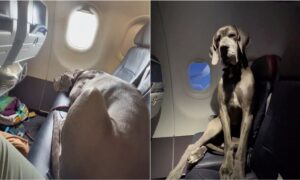“This post contains affiliate links, and I will be compensated if you make a purchase after clicking on my links.”
Many dog owners want to take their four-legged family members on vacation with them. But, when the destination is more than driving distance away, sometimes flying is the only option to get them there. Flying pets in the cargo hold area of an airplane does have it’s dangers, especially for brachycephalic, or short-faced, breeds. In fact, many airlines are now banning those breeds from airline travel. As reported in this article by Christine Haughney of The New York Times, banned by many airlines, these bulldogs fly private.
Banned by Many Airlines, These Bulldogs Fly Private
When Louie York flew cross country on Sept. 15, his route from New York was anything but direct. First came a stop in Chicago and then one in Omaha, where he endured a six-hour layover.
Next were Denver, Phoenix and, finally, Los Angeles, 18 hours later. The capper: a seven-hour drive home to the San Francisco Bay Area.
Such is life for travelers like Louie, a French bulldog whose breed has been banned from most commercial airlines — not for the dogs’ bark or bite, but because so many have died in flight.
Many airlines now forbid brachycephalic breeds, also known as short-faced or snub-nosed dogs, from their planes. That has caused great inconvenience for the owners of the affected dogs, which include popular breeds like pugs and bulldogs, but has opened a niche for a few companies that cater specifically to pet travel.
Pet Jets, which began offering charter plane service for pets two years ago, said these breeds made up about a quarter of their passengers. Pet Airways, a two-year-old airline dedicated to transporting pets, has seen a similar trend: of the roughly 4,900 dogs it has flown, about 25 percent were brachycephalic breeds.
On a recent Pet Airways flight from Republic Airport in East Farmingdale, N.Y., 5 of the 15 canine passengers were brachycephalic breeds, including Louie. In the terminal, wealthy and middle-class pet owners crossed paths. The scene at the check-in counter was certainly unusual: a bulldog and pug panted as they waited behind Louie and his owner, Rusty Rueff.
“We always make a joke: He flies private and we fly commercial,” Mr. Rueff’s wife, Patti Rueff, said.
Mr. Rueff handed over Louie’s blue blanket and a plastic bag with his dog food and Pepcid AC. A Pet Airways worker gave Louie his boarding pass: a paper collar, wrapped around the dog’s neck. Louie responded by sending heart-wrenching glances toward his owner, seeming to protest his abandonment. But Mr. Rueff, who was rushing to catch his own flight on American Airlines that night, said the dog’s well-being outweighed any feelings of guilt, even with the $840 price for a one-way cross-country ticket.
“If he throws up or gets sick or goes bonkers, there’s going to be a human being there,” Mr. Rueff said. “That makes it worth it for us; we’re paying for peace of mind.”
Airlines have always had varying restrictions on animal travel. There are a few carriers, like Alaska Airlines, Frontier Airlines, Hawaiian Airlines and Sun Country, that still allow brachycephalic breeds to fly in cargo. And most animals are generally allowed to fly in the passenger cabin if they weigh less than 20 pounds, as some French bulldogs and many pugs do.
But the clear trend among commercial airlines is toward an outright ban on brachycephalic breeds.
American Airlines banned brachycephalic breeds of dogs and cats shortly after four bulldogs died on its planes in a three-month period in 2010. Delta stopped accepting French, English and American bulldogs this year, after three bulldogs died from January to March.
United and Continental Airlines, which had two bulldogs die in their care this spring, banned brachycephalic dog breeds from flying during the summer, lifting the restriction on Sept. 16, when temperatures began to drop.
According to the federal Agriculture Department, 189 animals died on commercial flights from June 2005 to June 2011; of those animals, 98 — more than half — were brachycephalic breeds.
The breeds, which also include Persian and Himalayan cats, have smaller openings to their noses and elongated soft palates on the roofs of their mouths, which make breathing more difficult for them, veterinarians said. Those breathing problems can be magnified in stressful situations like air travel, and further exacerbated in extreme heat.
The airlines’ growing no-fly lists have set off a debate between pet owners and veterinarians about whether these dogs should fly at all.
Some veterinarians who have operated on the dogs to open up their nasal passages said that surgery could help somewhat with breathing and perhaps make flying safer. Other veterinarians refuse to sign medical paperwork allowing the dogs to fly in cargo.
“I’m seeing more people who want to travel with their pets in the last 10 years,” said Amy Attas, a veterinarian who runs a house call service, City Pets. “The first conversation I have with people is, ‘Why are you bringing your dog in the first place?’ Every veterinarian has known: don’t fly a brachycephalic dog, because dogs regulate their body temperatures through their noses.”
You can read the rest of Christine’s article here. We love the idea of pet-only airlines so that when banned by many airlines, bulldogs can fly private. Have you ever used one to transport your pet? Or, do you have an experience with flying your pet in cargo hold that you’d like to share with us? Use the comment box below.























